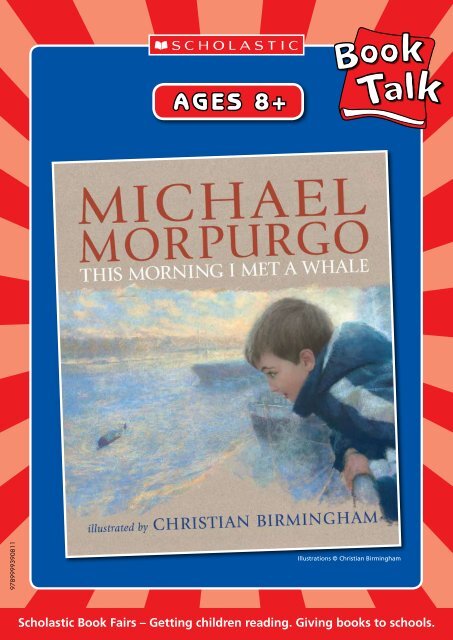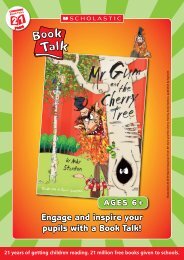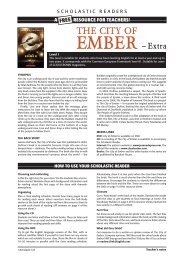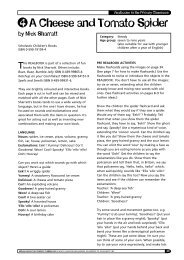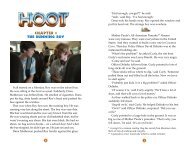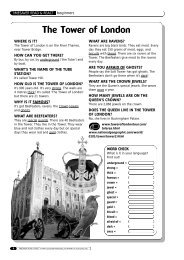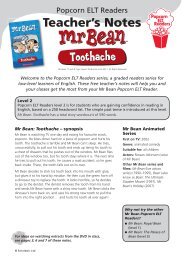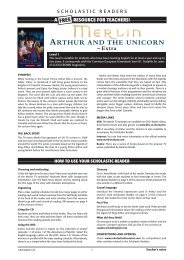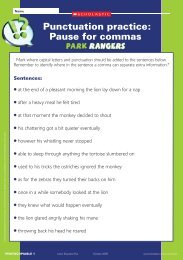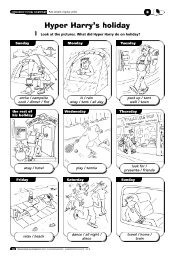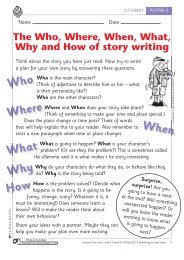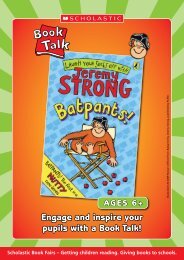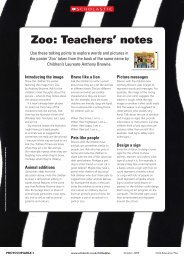This Morning I Met a Whale - Scholastic
This Morning I Met a Whale - Scholastic
This Morning I Met a Whale - Scholastic
You also want an ePaper? Increase the reach of your titles
YUMPU automatically turns print PDFs into web optimized ePapers that Google loves.
AGES 8+<br />
9789999390811<br />
Illustrations © Christian Birmingham<br />
<strong>Scholastic</strong> Book Fairs – Getting children reading. Giving books to schools.
AGES 8+<br />
Look out for this<br />
book at your Fair!<br />
Price £4.99 / h6.40<br />
Case Read On<br />
Author Michael Morpurgo<br />
Illustrator Christian Birmingham<br />
Publisher Walker Books<br />
Themes<br />
Using this book in your classroom<br />
<strong>This</strong> story has a strong theme of respect for the environment, and reflects on the<br />
relationship between people and animals.<br />
Summary<br />
Michael often goes bird watching down by the River Thames in London. It’s peaceful<br />
down there at sunrise, and Michael almost has the river to himself. One morning,<br />
however, he is amazed to see a whale swimming towards him. He thinks he’s dreaming,<br />
but the whale is real – and it needs Michael’s help.<br />
Boy and whale share a moment of intense communication. The whale shows Michael<br />
scenes of the damage that humans are doing to the environment, and makes Michael<br />
promise to spread the message that the damage has to stop. When Michael goes to<br />
school that morning, he writes a story about the whale – the best one he has ever<br />
written. His teacher and class think that it’s a made-up story, but Michael knows it’s<br />
true. And soon everyone else knows it too, as the news breaks that a whale really has<br />
made its way down the Thames.<br />
The whale draws huge crowds, but Michael manages to get to the front, and with his<br />
teacher and mother’s help, he even joins the rescue team as they try to guide the whale<br />
back to safe waters. Unfortunately, the dangerous journey down the shallow river is<br />
too much for the whale and it dies before it can reach the safety of the open sea. But<br />
Michael has made a promise to the whale – he will spend his whole life trying to spread<br />
the message of care for the environment.<br />
Did you know?<br />
• Michael Morpurgo has written more than one hundred books.<br />
• As well as writing for children, Michael runs the charity Farms for City Children<br />
(FFCC), together with his wife Clare.<br />
<strong>Scholastic</strong> Book Fairs – Getting children reading. Giving books to schools.
The Story Session<br />
1. Introducing the story<br />
Ask the children how they would feel if they suddenly saw a whale swimming in a<br />
river in the heart of a big city. Would they believe it was true? Would they want to find<br />
out more about the whale and how it came to be there? Read the blurb, and tell the<br />
children that the idea for this story came from a true incident in January 2006 when a<br />
northern bottle-nosed whale was spotted in the Thames in the centre of London.<br />
2. Reading the story<br />
• If time allows, read from the start of the book to the end of Michael’s story on page<br />
43. If you are short of time, you could stop at the bottom of page 34 (“... and that’s<br />
why I have come.”) Ask: “Why do you think the whale has come down the river? Why<br />
is he looking for a child to tell his story to, rather than an adult? What do you think he<br />
wants Michael to do for him?”<br />
• Ask the children how they would feel if they were Michael. Would they want to help<br />
the whale? Would they tell other people about what had happened?<br />
• If you have time, you could read the rest of the book to the children in a further<br />
session – or encourage them to read it individually or in reading groups. After reading<br />
the story, talk about why Michael Morpurgo decided to write a story based on the true<br />
incident of the whale in the Thames. What message do they think the author wants to<br />
give us in this book? Do they think this is an effective way of encouraging us to look<br />
after the environment?<br />
3. Follow-up<br />
• What do the children think Michael could do to keep his promise to the whale, to<br />
help people stop damaging the environment? Together, make a list of ideas. Which of<br />
these ideas could the children do themselves? Try to find one or two positive things<br />
that you can do as a class to help the environment.<br />
• Encourage the children to use books and websites to research ways of helping to<br />
preserve the environment. Several environmental charities have useful websites, for<br />
example WWF (www.wwf.org.uk) or Friends of the Earth (www.foe.co.uk/learning).<br />
• Children may be interested to find out about the true story of the northern<br />
bottle-nosed whale that ended up in the Thames in January 2006. The website<br />
www.thameswhale.info is a good place to start. They could compare the true<br />
events with the story as presented in this book.<br />
Visit bookfairs.scholastic.co.uk for more resources<br />
<strong>Scholastic</strong> Book Fairs – Getting children reading. Giving books to schools.


